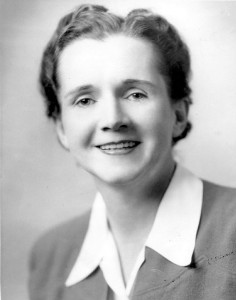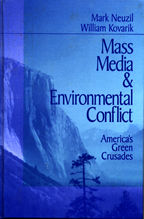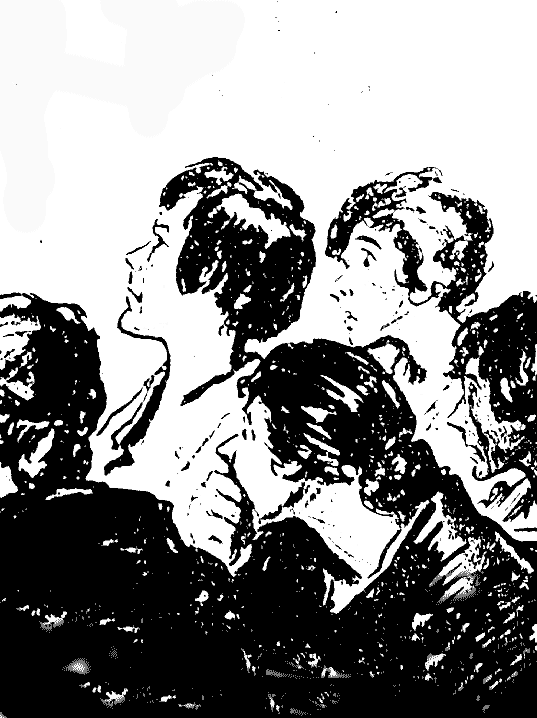By Bill Kovarik, for Radford Women’s Forum, March 9, 2010
Appreciation for the history of women, minorities, labor and social movements is long overdue, since these stories are just as close to the heart of the democratic experience, or perhaps closer, than many found in traditional American history textbooks.
Especially interesting is the leading role women played in the nation’s early environmental movement. This movement began at least a century and a half ago, peaked in the Progressive era of the 1890s, and then declined during the war years in the early- to mid-20th century.
The environmental movement was revived in 1962 with the publication of Silent Spring, a book about the dangers of pesticides, by Rachel Carson. Although Carson is well known, the women at the other end of this historical continuum who started the environmental movement are hardly known at all.
Ellen Swallow Richards (1842-1911) was a pioneer of the women’s environment movement. In 1873, Richards began the nation’s first systematic survey of river and stream pollution for Massachusetts Institute of Technology. A Vassar graduate, Richards had asked simply to study at MIT, but she impressed the college president and was formally admitted as MIT’s first female graduate student. During the 1870s Richards created new methods for measuring pollution from sewage and industry. She also helped establish the first state experimental station for water pollution research in Lawrence, MA.
Richards was known as a proponent of “euthenics” — an idea concerned with the improvement of the environment, both in and out of the household. (The term was meant to be the opposite of “eugenics”). In her books and studies over the next 40 years, Richards fought for clean kitchens, clean water and clean cites. She advocated “ecology” in a broad sense as a woman’s responsibility and began what she first called the “home ecology” movement. The idea was soon broadened into “home economics,” a field that was taught in most American universities in the early to mid-20th centuries, fell out of favor in the 1970s, and is recently undergoing something of a revival in the form of “human ecology” studies at some universities.
Among her many accomplishments, Richards’ research demonstrated the need for Massachusetts factory and food inspection laws — the first in the nation. She was also involved in the development of sanitary sewer treatment systems and many other environmental projects.
Richards was never allowed to finish her graduate degree, but she did not fight the prevailing prejudice directly. She even cleaned house for some of her professors. “Perhaps the fact that I am not a radical,” she wrote her parents, “and that I do not scorn womanly duties, but claim it as a privilege to clean up and sort of supervise the room and sew things, is winning me stronger allies than anything else.”
Someone at MIT must have agreed, and she became an instructor in sanitary chemistry at the Women’s Laboratory at MIT in the mid-1880s. Richards is remembered today as a pioneer for women in science, partly because she had “figured out a way to connect (science) with household cleaning,” the New York Times said in a belated 2005 acknowledgement of her role. But Richards did more than that – she connected the ills of the household with the ills of the community, and urged women to get out and do something about bad food, impure water and unsanitary sewage treatment.
Women’s clubs and “municipal housekeeping”
“Municipal housekeeping” was the label placed on Richards’ vision of the new role for women as environmental and social advocates at the community level. Within a generation, the vision had been widely taken up by thousands of newly formed women’s clubs. New York journalist Jane Croly had formed a small New York city club after being barred in 1868 from a lecture by Charles Dickens, and 20 years later, she led related organizations that formed the General Federation of Women’s Clubs.
From the 1890s to around 1917, over a million women used these clubs as a base to organize for conservation and urban renewal, and against child labor and sweatshop practices. This movement was the heart of what is now known as the Progressive era. The GFWC had national committees on forestry, waterways and rivers, child labor and other issues. “The rationale for women’s involvement lay in the effect of waterways on every American home: Pure water meant health; impure meant disease and death,” said historian Carolyn Merchant.
While the women’s clubs of California worked to save the sequoia forests and the Hetch Hetchy valley, their counterparts in New York opposed hydroelectric plants at Niagra Falls. In New Jersey, the women’s clubs were focused on saving the Palisades of the Hudson River from a stone quarry, while the Progressive women of Colorado were saving cliff dwellings and pueblo ruins from vandalism.
The women’s clubs also worked on the national level to end the importation of tropical bird feathers for hats, to support wise use of forest resources, to pass pure food and drug laws, and to support the creation of national parks.
The women’s environmental movement should be seen in the context of a general national movement for women, with goals that included the right to vote, equal treatment for women, and higher education for women.
The movement’s intent was not simply to improve the condition of women, but more importantly, to empower women to serve and improve their communities in ways that expanded traditional roles.
Contributions from Hull House
An important leader of the Progressive reform movement was Jane Addams (1860-1945), the first American woman to receive the Nobel Peace Prize. In 1889, Adams founded Hull House, a center for social reform in of one Chicago’s most squalid slums. Hull House was a community center based on the concept of “settlement houses” that provided a base for middle class women who were dedicated to public service but who had often been barred from professions or a university education.
Adams had been inspired by Ellen Swallow Richards and the women’s club movement, but was particularly inspired by a 1887 visit to Toynbee House in London’s East End. She brought the settlement house concept back to Chicago two years later, and Hull House became a famous national example of what women could accomplish.
Addams and colleagues worked on things many people today take for granted, included garbage cleanup, sewer installation, street lighting, clean drinking water, child labor laws, food inspections, health and medical services, fighting epidemic disease and many other urban environmental issues. Addams was so successful that by 1920 there were nearly 500 settlement houses in most major US cities.
Among the many residents who worked with Addams at Hull House were Alice Hamilton (1869-1970), a young MD whose experiences inspired her reform efforts on behalf of workers in dangerous trades, and Florence Kelly (1859-1932), an “impatient crusader” against child labor and abusive conditions in women’s workplaces.
Florence Kelly
Kelly was a tireless advocate for child labor laws, civil rights, and better working conditions. In 1892, while she worked at Hull House, Kelly was asked by the state Bureau of Labor Statistics to investigate child labor. One of her reports noted:
“Some of the children are boys who cut up the animals as soon as the hide is removed… These children stand, ankle deep, in water used for flooding the floor for the purpose of carrying off blood and refuse into the drains; they breathe air so sickening that a man not accustomed to it can stay in the plant but a few minutes; and the work is the most brutalizing that can be devised…” (Sass, 1999).
In 1899 Kelly moved to New York and founded the Henry Street settlement house, and, a year later, the National Consumers League, both of which are thriving today. The League worked with women’s clubs nationwide to limit child labor and establish an eight hour work day, and because of her work, state limits on women’s work were upheld by the Supreme Court in 1908. She also helped found a federal agency called the US Children’s Bureau 1912 that fought for pure milk, pure food and better conditions for children.
Alice Hamilton
Alice Hamilton also went to work at Hull House in the early 1890s, after earning a medical degree in 1893. She was a professor of medicine at the Women’s College of Northwestern University in Chicago and, like Addams and Kelly, became increasingly alarmed at the environmental conditions in the slums. Without support from industry or government, Hamilton conducted studies on lead and mercury poisoning in the Chicago area. She was also concerned with public health, and during a typhoid fever epidemic in 1902, Hamilton helped convince Chicago authorities that improper sewage treatment was spreading the disease. When the state’s Occupational Disease Commission was created in 1910, she became its first director and helped pass some of the first workers compensation laws.

Hamilton’s tours of Illinois industries uncovered hundreds of cases of outright lead poisoning, some of which were quite severe. As Hamilton put it, conditions were “equal to those described by French authorities of the early 19th century.” Shocked that Illinois was a century behind Europe, the legislature quickly passed a law requiring ventilation and other safety standards for workers.
The Illinois study brought Hamilton to the attention of the U.S. Department of Labor, where she worked from 1910 to 1919 as a special investigator of industrial poisons. She was then invited to join the faculty at Harvard University. From then until her retirement she served at Harvard and became an internationally recognized expert in hazardous trades and environmental issues. She worked on such controversies as the leaded gasoline issue of 1924-26 and the “radium girls” case of 1929. Although she reached the pinnacle of a scientific career as the first woman on the Harvard faculty, Hamilton still had to enter the faculty club by the back door and still had to promise not to attend football games.
Caroline Crane
Another environmental reformer inspired by Addams was Rev. Caroline Bartlett Crane, a former journalist and pastor of a Unitarian church in Kalamazoo, MI, who organized “new and untried kinds of social service,” including discussion groups on civic problems. When she could not find a speaker to discuss meat inspection in 1902, she began researching the subject herself. Along with members of the women’s club, she visited nearby slaughterhouses and was shocked by the grossly unsanitary conditions and the discovery that no distinctions were made between healthy and diseased animals.
Crane disclosed these conditions to the city council, but learned that it had no jurisdiction over businesses located outside city limits, as these were. The state board of health took no action either. Crane made a study of meat inspection laws in other states and drafted a proposed law that gave cities the right to regulate meat sold within their limits. Her bill became law in the spring of 1903, and a year later she founded the Women’s Civic Improvement League of Kalamazoo.
Her successes led to requests for help in other cities, and Crane became a traveling consultant for sanitary planning to dozens of cities. A visit to Uniontown, Pennsylvania, for example, resulted in the condemnation of the public water supply; a tour of Kentucky cities resulted in the establishment of a state bacteriological laboratory.
Crane insisted that women take a share of the responsibility for the cleanliness of their cities, advising: “We certainly should keep our city — that is to say, our common house — clean. The floor should be clean. The air should be clean…” She saw “municipal housekeeping” as a non-partisan responsibility that should involve not only women, but rather, the whole community working in a partnership with local government.
Conclusion
In spite of their contributions, women were systematically excluded from mainstream political and social systems around the turn of the century, and their environmental and political contributions at this time were often made in parallel to, rather than within, the mainstream. The movement faded when many of their objectives were met, including the right of women to vote, and when many other objectives became part of the New Deal in the 1930s.
The Progressive movement also faded during the “red scare” of the 1920s, in which politically motivated charges were brought against men and women who were organizing labor unions and fighting for better working or environmental conditions. Alice Hamilton noted in 1925 that she had often been charged with “sentimentality if not socialism,” while Florence Kelly spent the last years of her life defending herself against accusers. The awarding of a Nobel Peace Prize to Jane Addams in 1931, like many subsequent awards, involved not only recognition but also the hope of protection for her work.
And yet, the tenacity of these and many other women in the environmental and public health areas is remarkable. Women became so identified as the caretakers of environmental causes that, as late as 1948, a New York Times editorial would “urge housewives and others to take this opportunity” to attend an anti-smoke political rally.
And many of the institutions founded by the women’s environmental movement still exist today – for example Hull House, Henry Street settlement, and Toynbee Hall, along with the National Consumers League and the General Federation of Women’s Clubs.
Change comes from within, as the old saying goes. It comes from within the people of a democracy, and Richards, Croly, Addams, Kelly, Hamilton and Carson are among those whose personal determination created the first wave of an expanding world environmental movement.
Following their examples today we find a long list of Americans and Europeans, as well as Wangari Maathai of Kenya’s Greenbelt Movement, Chandi Prasad Bhatt of India’s Chipko movement and Maria Cherkasova of Russia’s Socio-Ecological Union.
The legacy is enduring, the debt is profound, and at the very least, historical appreciation of the women’s movement to protect their homes and their environments is long overdue.
FOR MORE INFORMATION:
- Hull House, Chicago
- Toynbee Hall, London
- Henry Street Settlement House, New York
- National Consumers League
- General Federation of Womens ClubsREFERENCES__ “An Anti-Smoke Rally,” New York Times, Nov. 18, 1948: 26:3.
__ “The Revenge of Ellen Swallow (Richards),” New York Times, Feb. 20, 2005.
Jane Addams, Twenty Years at Hull House, New York: Macmillan, 1948 (first printed in 1910).
Caroline L. Hunt, The Life of Ellen H. Richards, Boston, Whitcomb & Hunt, 1912.
Suellen M. Hoy, “Municipal Housekeeping: The Role of Women in Improving Urban Sanitation Practices,” in Martin V. Melosi, ed., Pollution and Reform in American Cities 1870 – 1930, Austin, University of Texas Press, 1980.
Mary S. Gibson, ed., A Record of Twenty Five Years of the California Federation of Women’s Clubs, 1900 – 1925, Pasadena, CFWC, 1927.
Carolyn Merchant, “The Women of the Progressive Conservation Crusade: 1900 – 1915,” in Kendall E. Bailes, ed., Environmental History: Critical Issues in Comparative Perspective, (NY, University Press, 1985): 156.
Sass R. The unwritten story of women’s role in the birth of occupational health and safety legislation. Int J Health Serv. 1999;29(1):109-45.
Barbara Sicherman, Alice Hamilton: A Life in Letters (Cambridge, Mass., Harvard University Press, 1984),
Marcia Yudkin, “Earth, Air, Water, Hearth: The Woman Who Founded Ecology,” Vassar Quarterly, Spring 1982: 32-34.


 Revolutions in Communication
Revolutions in Communication Mass Media & Environmental Conflict
Mass Media & Environmental Conflict